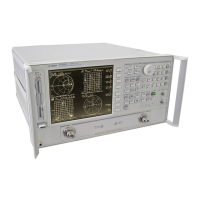5-48
Hardkey/Softkey Reference
Analyzer Functions
isolation is an impedance-matched load (usually 50 or
75 Ωs). Response and directivity calibration procedures
for reflection and transmission measurements are
provided in the following pages.
turns off the tabular listing and returns the measurement
display to the screen.
eliminates the need to restart a calibration sequence that
was interrupted to access some other menu. This softkey
goes back to the point where the calibration sequence was
interrupted.
when on, causes the analyzer to retrace the sweep only
over the current frequency range, and does not turn off the
power during retrace, unless crossing a 20.05 GHz source
band. When in STD mode, the analyzer may turn off the
source power, or sweep to a lower frequency if it provides a
faster retrace.
measures the reverse isolation of the calibration standard
during an enhanced response cal.
measures the reverse isolation of the calibration standard
during a full 2-port cal.
(Label Class) lets you enter a label for the reverse match class. The label
appears during a calibration that uses this class.
(Specify Class) specifies which standards are in the reverse match class in
the calibration kit.
is used to enter the standard numbers for the reverse
match (thru) calibration. (For default kits, this is the
thru.)
(Label Class) lets you enter a label for the reverse transmission class.
The label appears during a calibration that uses this class.
(Specify Class) specifies which standards are in the reverse transmission
class in the calibration kit.
is used to enter the standard numbers for the reverse
transmission (thru) calibration. (For default kits, this is
the thru.)
provides access to the menu for selecting an open
calibration type when the cal kit defines more than one
open standard.
adjusts the source frequency higher than the LO by the
amount of the LO (within the limits of the analyzer).
adjusts the source frequency lower than the LO by the
amount of the LO (within the limits of the analyzer).

